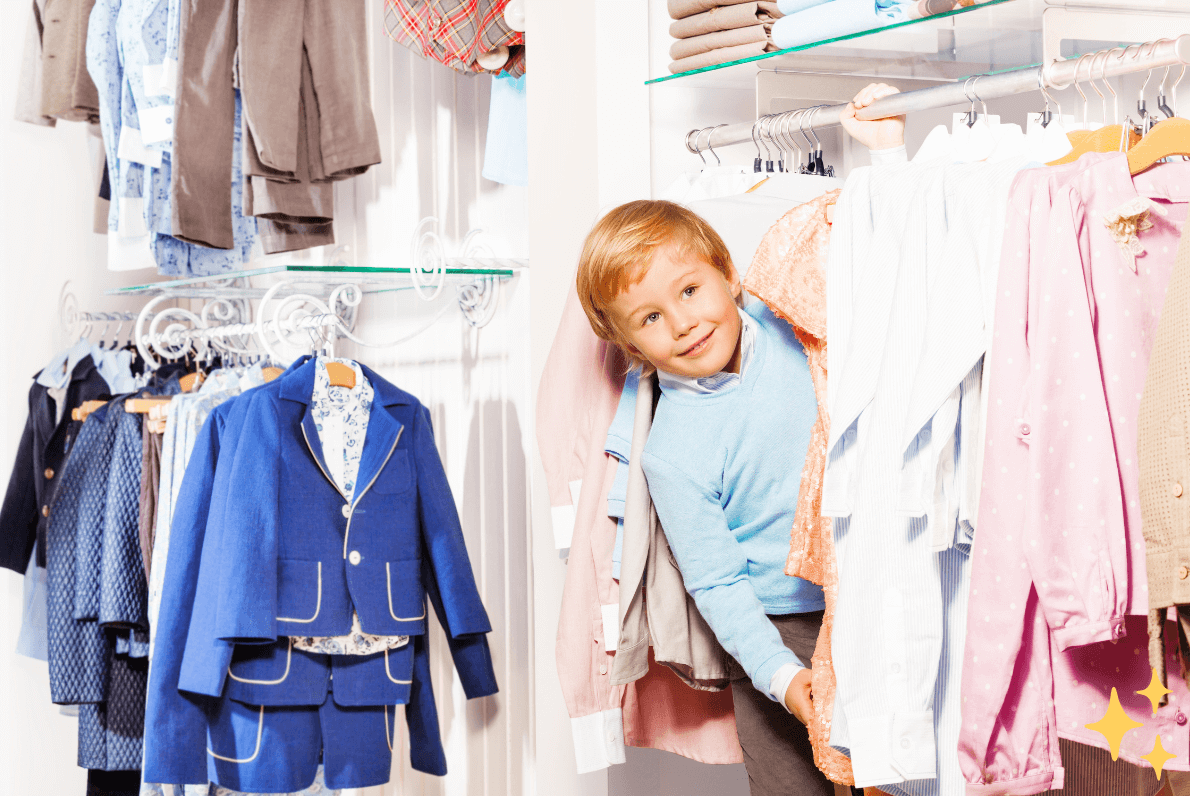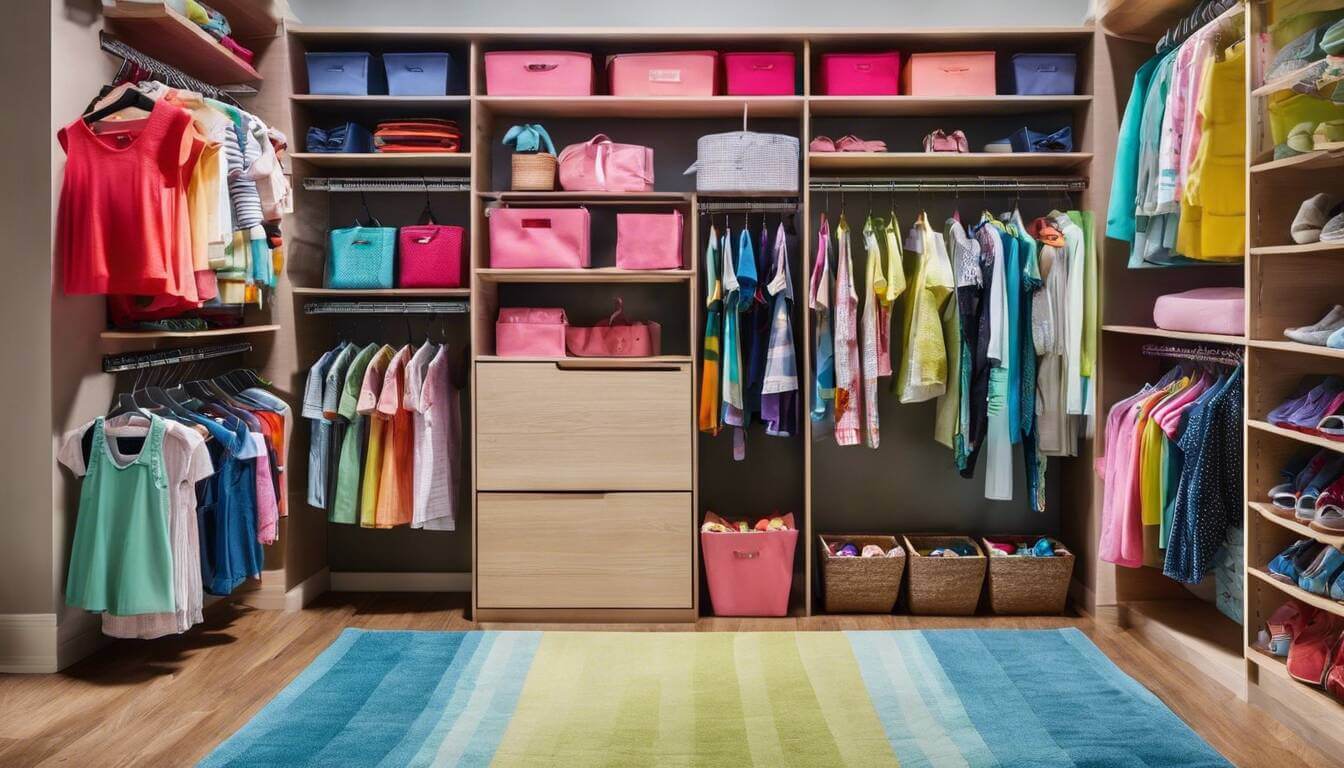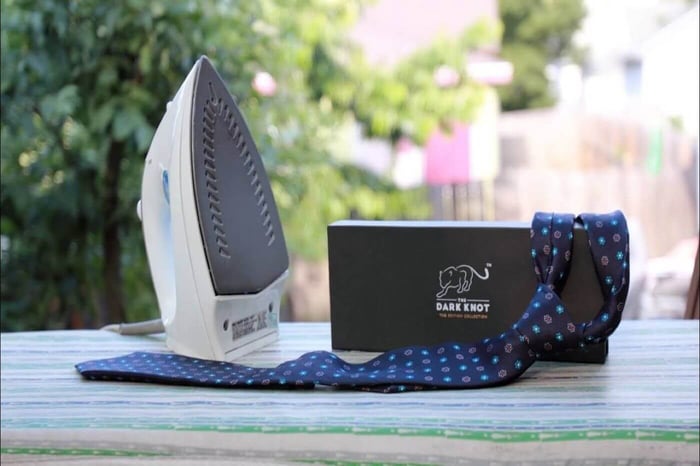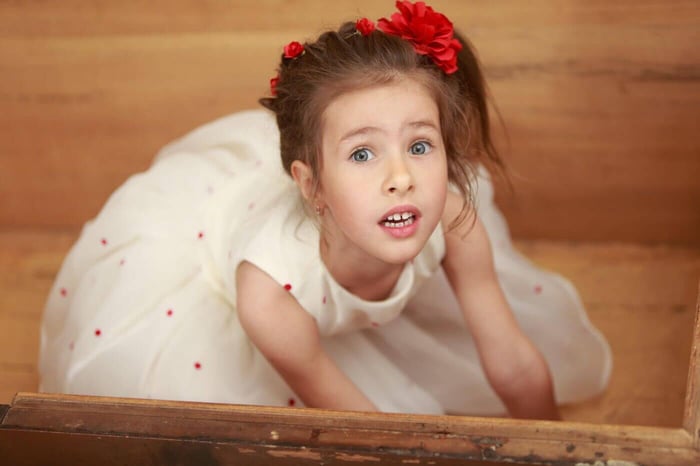
Knowing how to organize kid's clothes isn't as tricky as it seems. Firstly, it all begins with a pre-organization purge, sorting out clothes that no longer fit or are in poor condition. But, in an unexpected twist, this doesn't mean merely dumping old clothes - consider donating wearable items or even upcycling them into something useful. Now, there's more room in your child's closet for easy organization. Just watch, you'll not be digging through mountains of mismatched socks anymore.
The best way to organize kids' clothes is by using labeled size dividers in their closet to separate different sizes. Additionally, using clear zip-up bags for off-season or off-size clothing, and utilizing under-bed storage bins for storing hand-me-downs and next season's clothes can be effective in maintaining a well-organized clothing system for children.

Inovative Idea: You May Want To Choose the Nori Press To Keep All Your Clothes Looking Their Best
When dealing with the hassle of ongoing wardrobe maintence, it's worth considering innovative alternatives. The Nori Press offers several compelling advantages that make it a superior choice for those looking to simplify their garment care routine:
-
Efficient Design: The Nori Press features a dual-heated, non-stick ceramic soleplate that glides smoothly over fabrics without the risk of sticking or pulling. This ensures a crisp finish without the need for frequent cleaning of starch residues, which is often a cumbersome task with regular irons.
-
Time-Saving: With the ability to press both sides of a garment simultaneously, the Nori Press cuts down ironing time dramatically. This is a significant advantage for those with busy schedules who still want to maintain impeccably pressed clothes.
-
Portable and Convenient: The compact and lightweight design of the Nori Press makes it ideal for travel and quick touch-ups. In contrast, traditional steam irons are often bulky and require a sturdy ironing board to operate, which is not always practical for small spaces or on-the-go needs.
-
Eco-Friendly: By eliminating the need for steam, the Nori Press uses less energy compared to traditional steam irons. This energy efficiency makes it a more environmentally friendly option for conscious consumers looking to reduce their carbon footprint.
-
Versatile Fabric Care: Designed to be safe and effective on a variety of fabrics, from delicate silks to sturdy denims, the Nori Press ensures optimal care for your entire wardrobe without the risk of burning or shine marks often left by traditional irons on sensitive materials.
By switching to The Nori Press (Use discount code "SHOP10" at checkout to save 10% on The Nori Press!), you can enjoy a hassle-free, efficient, and more sustainable way to keep your clothes looking their best, eliminating the need to frequently deal with the challenges of cleaning starch off traditional irons.
Pre-Organization Purge: Getting Rid of Unnecessary Clothes
Before delving into how to organize kid's clothes, it's crucial to take stock of what you have and determine what needs to stay and what needs to go. It's akin to cleaning out a garden before planting new flowers—without clearing away the weeds first, the garden won't flourish.
Go through each item one at a time. Does it still fit your child? Is it in good condition? Will it actually be worn? Remember, kids grow quickly, and their tastes change even quicker. What might have been a favorite shirt or dress last summer may now be relegated to the back of the closet, never to see the light of day again.
If clothes are damaged beyond repair or are simply too small for your child, it's time to part ways with them. This creates valuable space for an efficient organization system, making it much easier to locate and access the clothes that do remain.
Just think of it as making room for new adventures! You never know when that extra space could come in handy for those future purchases or hand-me-downs from friends or siblings.
By decluttering and purging unnecessary items, you're setting the stage for a well-organized and efficient clothing storage system that will save you time and energy in the long run.
In paving the way for streamlined clothing management, the pre-organization purge serves as the essential groundwork for creating an organized oasis within your child's closet.
Categorize Apparel by Type and Size
Imagine waking up in the morning, trying to get your kids ready for school, and not being able to find their favorite shirt or pants. It can be frustrating, right? That's why it's essential to categorize and arrange their clothes by type and size.
First, let's talk about categorizing by type. This includes separating tops, bottoms, dresses, and outerwear. By doing this, you'll create specific sections for each type of clothing, making it easier for both you and your children to find exactly what they need.
Next, we have arranged by size. When you organize clothes by size, you can quickly identify what fits your child now and what they will grow into. Using labeled dividers or separate bins for different sizes streamlines the process and helps in maintaining order. This setup really simplifies getting dressed in the morning as it's easy to pick out an outfit when everything is neatly sorted.
It could also be helpful to have separate sections for each clothing type and size range within the closet or dresser. For example, having an area specifically for "6-12 months tops" or "2T bottoms" aids in quickly identifying the right size.
Now, let's tackle how to optimize drawer space so that everything stays orderly.
For a seamless and clutter-free wardrobe system, efficient labeling and sectioning are key. Now let's delve into implementing your system: creating labels and sections to sustain this streamlined organization.
Implementing Your How To Organize Kid's Clothes System: Creating Labels and Sections
Once you've sorted clothes by type and size, it's time to ensure that everyone in the house knows where everything goes. Clear labels play a crucial role in maintaining the consistency of the organizational system you've worked so hard to create.
Labeling for Clarity
Start by using labels or fabric markers to mark sections and bins for different types and sizes of clothes. For example, you can have separate areas for tops, bottoms, pajamas, school uniforms, or play clothes. The key is to make it easy for adults and children to quickly identify where each item belongs. You want the labeling to be clear, specific, and easily visible, especially for younger kids who may still be learning to read. This approach will not only help maintain a consistent and organized setup but also facilitate independent maintenance of the system.
You might opt for color-coding as well in conjunction with text labels. For example, blue labels can indicate boys' clothes, while pink labels can signify girls' clothes. This adds an extra layer of visual guidance that can be especially helpful for young children who might not be able to read yet. Tedious as it sounds, it's the small details like these that make the organization routine fun and engaging for kids while promoting independence in maintaining their own space.
Setting Up Specific Sections for How To Organize Kid's Clothes
Now that your clothes are sorted and labeled appropriately, dedicate specific areas or drawers for different categories of clothing. Having designated zones for items such as pajamas, school uniforms, or play clothes can contribute significantly to a more organized setup. When everything has its place, it makes it much easier for kids (and even adults) to quickly find what they need without creating a mess in the process.
Furthermore, consider the ease of accessibility when setting up these sections. For instance, keep school uniforms within easy reach to streamline those chaotic weekday mornings. Prioritizing accessibility ensures that everyone in the household can easily maintain the system without becoming frustrated or resorting to disorderly habits.
By establishing clear labels and dedicated sections, you're making it easier for both kids and parents to navigate through the organization system without feeling overwhelmed.
Exploring Storage Solutions: Bins, Baskets, and Beyond
Kids' clothes can fill up space quickly, and it doesn't take long to go from organized to chaotic when dealing with a growing collection. Bins, baskets, and storage boxes are essential tools for keeping things under control. They not only provide a designated place for every item but also significantly contribute to the overall organization of the closet or dresser.
Investing in clear storage bins is a smart move. These allow kids to see what's inside without having to dig through them, making it easier for them to find what they need. It also helps to teach them about the organization as they can visually see where each type of clothing is stored. This clear visibility promotes independence and tidiness.
On the other hand, decorative baskets are great for adding a touch of style to the organization system. Nori.co offers a range of aesthetically appealing and functional storage baskets that can elevate the visual appeal of your storage space while maintaining functionality. These baskets not only serve as practical storage solutions but can also enhance the overall aesthetic of the room.
When considering which storage solution to use, it's important to think about how easily accessible you want the items to be. For example, if you're organizing frequently used items such as socks and underwear, having them in an open-top basket might be the most practical solution. But for items that are rotated out seasonally, a lidded container may be more suitable.
Moreover, using different sized bins or baskets for various items can streamline and optimize the organization process further. Larger bins can be used for storing bulkier items like jackets and sweaters, while smaller ones are perfect for tiny accessories such as hair clips or belts.
For instance, utilizing shallow baskets for stacking pajamas or folded clothes can make things easily visible and accessible within drawers. This kind of segmented organization within drawers prevents clothes from becoming disheveled every time kids need something at the bottom of the pile.
By incorporating well-designed storage solutions from Nori.co into your organization system, you'll not only keep clutter at bay but also uplift the visual aesthetic of your space.
As we contemplate ways to enhance functionality while maintaining an appealing layout in our organizational systems, let's turn our attention to strategies for optimally displaying kids' clothes.
Accessibility and Aesthetics: Displaying Clothes Optimally
When it comes to kids' clothes, the goal is to make it easy for them to select their favorite outfits while keeping the closet looking neat and inviting. One way to achieve this is by arranging frequently used items at their eye level—making it simple for kids to grab what they need without assistance.
Imagine a world where your child can get dressed without ending up with a tumble of clothes on the floor. By placing their most-loved and often worn items within reach, you're fostering independence while minimizing the chances of a wardrobe disaster.
But what about those seasonal or occasional clothing items that you don't need all the time? Well, these can be stored on higher shelves or in under-bed storage. This allows space for the everyday items at eye level, making it easier for your child to maintain the organization and find what they need when they need it.
Let's say your child has a special unicorn dress they only wear on birthdays or parties. Storing this dress out of the way, perhaps in an under-bed storage bin, ensures that it doesn't take up precious real estate in the daily rotation of clothing, while still being accessible when the occasion arises.
Additionally, using hangers, shelves, or hanging organizers can display clothing in an aesthetically pleasing manner. Not only does this encourage kids to maintain the organization, but it also makes choosing their outfits more enjoyable.
Picture colorful hangers holding up cute dresses and tiny shirts neatly folded on shelves. When everything is beautifully displayed, it not only looks nice but also makes it easier for kids to see what they have—resulting in fewer rummage sessions leading to chaos and frustration.
Another visually appealing approach is utilizing hanging organizers which come in various styles such as canvas cubbies or clear pockets. These are perfect for holding socks, underwear, accessories, and even shoes. A glance at an organized array of shoes and socks might just inspire your little ones to keep things tidy and make better outfit selections.
By considering both convenience and style when displaying your child's clothes, you're setting the stage for a well-organized and visually appealing closet that delights both parents and kids alike. In setting up an organized and visually appealing closet for kids' clothes, regular maintenance is key to sustaining order. Let's explore how to keep clothes organized over time.
Regular Maintenance: Keeping Kids' Clothing Organized

After meticulously arranging your kids' clothes in their closet or dresser, the next crucial step is to establish a routine for maintaining the organization system. This ongoing endeavor ensures that the effort put into organizing isn't short-lived and prevents clutter from building up again.
Consider implementing a weekly tidying routine to keep things in order. Every week, set aside some time to go through the clothes with your children, ensuring everything is in its place. It’s an excellent opportunity to check if there are any pieces that no longer fit or need repair. Involving kids in maintaining their dressers can help teach them responsibility.
Regularly scheduled maintenance, such as a weekly check and rearrangement, ensures that the system remains effective and prevents clutter from building up.
Additionally, you can designate specific days each month for thorough inspections and rearrangements. This monthly check provides an opportunity to reevaluate the organization system. It's a chance to address any items that may have been overlooked during the weekly tidy-up session.
During monthly inspections, consider sorting through the clothes to see if there are pieces that can be reorganized based on changing seasons or growth spurts. This can prevent overcrowding and help maintain an efficient use of space within the closet or dresser. The inspection should also include assessment for any wear and tear on storage bins, dividers, or other organizing tools used. It's important to ensure these tools are still functional and not contributing to disorganization by being damaged or ineffective.
For example, let's say you notice that the drawer dividers have become loose due to repeated use. Instead of ignoring this issue and letting it hinder your organization efforts, you could take some time during your monthly maintenance to repair or replace these dividers before they cause chaos in your neatly organized drawers.
Regular upkeep not only keeps your kids' clothing organized but also nurtures a sense of responsibility in your children as they actively participate in maintaining their living space.
It's clear that establishing regular maintenance routines is essential for keeping kids' clothing organized and teaching valuable life skills along the way.
As we delve deeper into fostering responsibility and independence in children, it's vital to recognize how involving them in maintaining their living spaces can contribute significantly to their personal development.
Teach Kids Responsibility: Involve them in the Process
Children are naturally curious. For them, hands-on learning often has a more lasting impact than just being told what to do. Involving kids in the organization of their clothes not only teaches them about responsibility but also instills habits of cleanliness and organization from a young age.
By assigning simple tasks like folding, sorting, or putting away their clothes, kids learn to respect their belongings. This helps them understand that their clothes need care and attention. Moreover, when they participate in organizing their own space, they feel a sense of ownership and pride, which can further encourage them to keep their space tidy.
For instance, you could ask your child to fold and arrange their clean clothes in their drawer by assigning specific clothes to each section or compartment. This not only helps inculcate habits of tidiness but also fosters a sense of independence and accomplishment in the child.
Furthermore, involving children in organizing their clothes can be an opportunity for parents to teach them important life skills. They can learn about decision-making, categorization, and the concept of "a place for everything and everything in its place."
Teaching kids about organization can be compared to teaching them how to ride a bike. At first, it might seem challenging and require a lot of supervision, but with time and practice, children become more adept at it and eventually develop it into a habit.
Involving children in organizing their clothes is not just about shifting responsibilities; it's about fostering lifelong habits that contribute to their personal development.
Empowering children through the organization of their belongings sets the stage for seamless transitions as they grow. Now let's delve into preparing for changes with "Dealing with Seasonal and Size Shifts.
Preparing for Changes: Dealing with Seasonal and Size Shifts
Kids seem to outgrow their clothes in the blink of an eye. That cute little sweater that fit perfectly last winter is suddenly too snug. Before you know it, summer has arrived, and it's time to pack away all the cozy jackets and boots. It's a never-ending cycle of change, and as parents, being prepared for these transitions is crucial. So, let's explore some smart strategies for managing the ebb and flow of kids' clothing sizes and seasonal shifts.
At the end of each season, take some time to assess what still fits and what doesn't. This could be a fun activity where your child gets to try on different items while you make a game out of it. As you discover clothes that are now too small, pack them away neatly to make space for the new season's wardrobe. Utilize storage solutions like vacuum seal bags or under-bed storage from Nori to efficiently stow away items that are not currently in use.
For example, when summer is approaching, sort through your child's closet and dresser drawers to identify which clothes are too small or will be outgrown once winter arrives. By doing this at the end of each season, you're able to stay ahead of the game and avoid any last-minute scrambles for larger sizes during the peak shopping season.
In addition to sorting outgrown clothes, consider arranging hand-me-downs or future-size clothing in labeled bins or vacuum-sealed bags. Clearly mark each container based on its contents so that when the time comes, you can easily find what you need without shuffling through piles of clothes.
By staying organized and maintaining a clear plan for handling seasonal and size shifts in children's wardrobes, you'll not only reduce stress during this process but also ensure that your children are always dressed comfortably and appropriately for the changing seasons.
Keeping up with kids' clothing changes may sometimes feel overwhelming, but by staying one step ahead and using efficient storage solutions, you can make the process more manageable, leaving you more time for quality moments with your kids.
What are some practical tips for maintaining an organized kids' clothing system on a daily basis?
Some practical tips for maintaining an organized kids' clothing system on a daily basis include creating a designated laundry routine, using labeled storage bins or drawers for different types of clothing, organizing clothes based on size and season, and involving your children in the organization process. According to a study conducted by the National Association of Professional Organizers in 2023, involving children in the organization of their own belongings can increase their sense of responsibility and ultimately lead to better maintenance of an organized system.
Are there any special considerations for organizing different types of children's clothing (e.g., baby clothes, school uniforms)?
Yes, there are special considerations for organizing different types of children's clothing. Baby clothes, for example, require separate storage due to their smaller size and delicate fabrics. School uniforms, on the other hand, can be organized by creating designated sections within the closet or using uniform hangers. According to a survey conducted by Parenting.com, 75% of parents found that organizing clothes according to their specific categories made it easier for them to locate and dress their children efficiently.
What are some creative storage solutions for organizing children's clothes?
Some creative storage solutions for organizing children's clothes include using hanging closet organizers with labeled compartments, installing wall-mounted hooks for jackets and backpacks, utilizing under-bed storage bins for seasonal items, and repurposing bookshelves with bins or baskets for folded clothes. These solutions help maximize vertical space, create designated areas for specific items, and make it easier for kids to maintain an organized closet. According to a survey conducted by the National Association of Professional Organizers, 78% of parents reported feeling less stressed after implementing creative storage solutions in their children's closets.
How can I involve my children in the organization process to teach them good habits?
Encouraging children to be involved in the organization process is key to teaching them good habits. Start by making it a fun activity with games and rewards, such as a treasure hunt for matching socks or a race to fold clothes neatly. According to research by the University of California, involving children in organizing their own space at an early age fosters independence and responsibility, leading to better organizational skills later in life. By giving them ownership of their closet and teaching them the value of organization, you are setting them up for success.
Are there any recommended products or tools that can help with organizing children's clothes?
Yes, there are several recommended products and tools that can help with organizing children's clothes. One highly recommended tool is closet dividers, which help separate clothes by size or type, making it easier to find what you need. Another useful product is storage bins or baskets, which can be used to sort and store out-of-season clothes or items that are not frequently used. Additionally, investing in space-saving hangers, such as cascading hangers or velvet hangers, can maximize closet space and keep clothes organized. According to a survey conducted by The Spruce in 2023, 80% of parents found these tools helpful in organizing their children's clothes and reducing clutter in the closet.




![How to Get Highlighter Out of Clothes [20 DIY Tips] – Nori Press](https://dropinblog.net/cdn-cgi/image/fit=scale-down,width=700/34243516/files/featured/Highlighting_report_risk_of_stain_on_clothes.jpeg)

